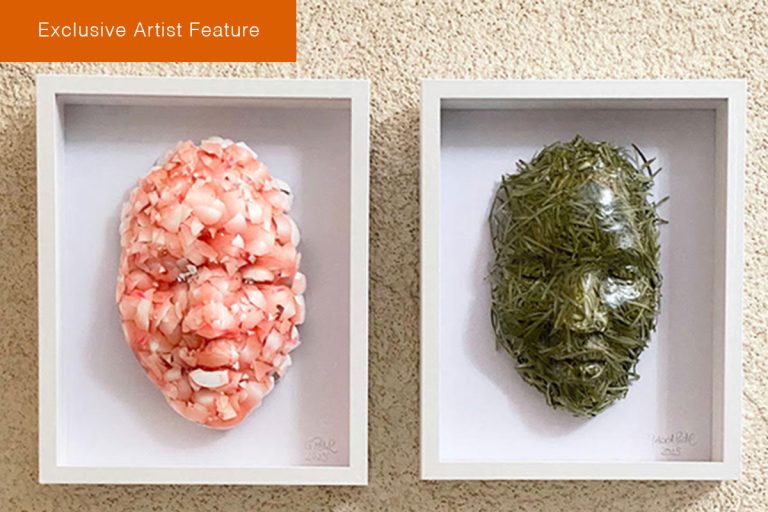Gerhard Petzl, a multi-disciplinary artist born in 1973 in Graz, Austria, has spent over three decades exploring the intricate interplay of shape, color, and texture across diverse materials. Now based in Vevey, Switzerland, and Kalsdorf/Graz, Austria, Petzl’s creative path reflects a lifelong curiosity about transformation. His work moves fluidly between bronze, stone, wood, and unexpected materials such as chocolate or recycled debris, revealing his willingness to blur boundaries between art and life. For Petzl, art isn’t just about the finished object—it’s about process, renewal, and awareness. Each piece becomes an extension of his ongoing exploration of how materials, once discarded or forgotten, can hold meaning again.
The Four Masks Collection

Gerhard Petzl’s Four Masks form a single conversation about fragility, transformation, and the hidden poetry of the everyday. Constructed from discarded organic matter—egg shells, fir needles, woodchips, and onion husks—each mask is preserved in resin, symbolizing both decay and endurance.
Fragile Egg Shells Mask, the orange-toned piece at the top left, was made from collected shells of soft-boiled eggs. Their delicate texture, sealed in resin, captures the tension between strength and vulnerability. Everyday breakfast remnants become a meditation on the fragile nature of life itself—how something easily crushed can also embody resilience when reimagined.
Next to it, Nordmann Fir Needles Mask, crafted from a recycled Christmas tree, carries a quiet nostalgia. Once part of a seasonal ritual, the tree’s needles now rest in resin, a frozen echo of celebration and transience. Petzl turns what was destined for disposal into a symbol of continuity—reminding us that even brief moments of joy deserve reverence and preservation.
The Woodchips Warrior Mask, in the lower left, feels more tactile and earthy. Using forest woodchips mixed with resin and later hand-painted, Petzl channels a primal energy. The result suggests a dialogue between nature and craftsmanship—raw material transformed into something ceremonial. The “warrior” quality comes not from aggression but from endurance, an ode to strength through adaptation.
Finally, Onion Lover Mask, made from onion husks left behind in the kitchen, embodies the cycle of domestic life. The layers of the onion mirror human emotion—each translucent husk hinting at what lies beneath. Embedded in resin, these remnants become tender artifacts of everyday ritual, showing that art can begin in the most mundane moments, like preparing a meal.
Through these four masks, Petzl’s practice becomes an act of quiet observation and respect for the materials that sustain daily life. He treats discarded objects not as waste, but as witnesses—tokens of time, use, and transformation.
Petzl’s approach dissolves the line between artist and life participant. Working, cooking, collecting, and creating are not separate acts but threads in the same weave. The resin, both literal and symbolic, preserves not just form but the spirit of continuation. His art becomes a living archive—of gestures, memories, and fleeting instants given permanence.
In this way, the masks remind us to look closer, to question what we overlook. Just as macro photography magnifies the unseen, Petzl’s works demand attention to subtlety. Eggshells, pine needles, wood shavings, and onion skins cease to be background—they become central to a dialogue about care, awareness, and interconnectedness.
“Moon and Earth”

In Moon and Earth (2025), Petzl shifts from organic matter to fabric and paint, yet the essence of transformation remains. Measuring 30×30 cm, this mixed-media piece begins with a purchased print—a found image that becomes the canvas for new life. Over this base, he layers aged cotton fabrics, a nod to his ongoing relationship with reuse and sustainability.
Using an acrylic airbrush, Petzl creates what he calls his “wrinkle designs,” patterns that evoke the surface of terrain, skin, or lunar landscapes. These wrinkles—both intentional and spontaneous—become part of his visual language. Later, he enhances them by hand with fine painted lines, merging control with chance, old with new.
“Moon and Earth” reads like a quiet reflection on time and renewal. The repurposed fabric holds a story of wear, while the overlay of paint gives it renewed identity. It’s an act of giving back—of taking something that has already lived and allowing it to live again through art.
Petzl’s consistent use of recycled and once-used materials reveals his philosophy: creation isn’t about beginning from nothing, but about re-seeing what already exists. Every work becomes a small rebellion against disposability—a reminder that beauty can emerge from what’s been overlooked.
In both the Four Masks and Moon and Earth, Petzl’s art functions as a bridge between the visible and the invisible, between decay and renewal. His materials carry memory, his methods carry intention. Through the quiet act of transformation, he invites us to notice how art can grow out of daily life—fragile, enduring, and profoundly human.

